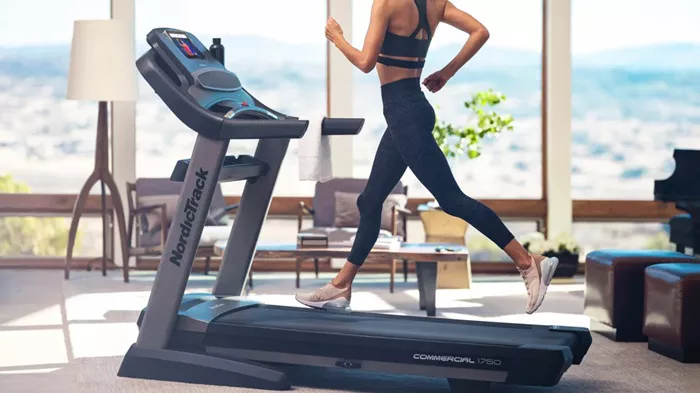Stationary bikes are a popular form of exercise equipment that offers numerous benefits, including cardiovascular conditioning, lower body strength building, and calorie burning. However, to maximize these benefits and avoid injury, it is essential to ride a stationary bike properly. In this article, we will provide a comprehensive guide on how to properly ride a stationary bike from a professional perspective.
Bike Setup
The first step in properly riding a stationary bike is ensuring the correct setup. This includes adjusting the seat height, seat position, and handlebar height.
Seat Height
The seat height is crucial as it affects your pedaling efficiency and can prevent knee pain and injury. To find the correct seat height, stand next to the bike and adjust the seat so that it is level with your hip bone. When you sit on the bike, your leg should be almost fully extended at the bottom of the pedal stroke, with a slight bend in the knee (about a 5 – 10 degree bend). If the seat is too low, you will have to work harder with your quadriceps and may experience knee strain. If it is too high, you may have difficulty reaching the pedals and could also cause stress on your hips and lower back.
Seat Position
The seat position, both forward and backward, also matters. Sit on the bike and place your feet on the pedals at the 3 o’clock and 9 o’clock positions. The front of your knee should be directly above the pedal spindle. If the seat is too far forward, it can put excessive pressure on your knees. If it is too far back, you may not be able to generate enough power and may feel unstable.
Handlebar Height
The handlebar height should be adjusted according to your comfort and riding style. For a more upright and comfortable position, especially for beginners or those with back issues, the handlebars can be set at a similar height or slightly lower than the seat. However, for a more aggressive and aerodynamic position, such as for those training for cycling competitions, the handlebars can be set lower. But be cautious not to set them too low as it can strain your back and neck.
Warm-Up
Before starting a stationary bike workout, it is essential to warm up your body. A proper warm-up helps increase blood flow to the muscles, raises your heart rate gradually, and prepares your joints for the upcoming exercise.
Dynamic Stretching
Begin with 5 – 10 minutes of dynamic stretching. This can include leg swings, hip circles, and arm circles. For leg swings, stand next to the bike and swing one leg forward and backward, then side to side, gradually increasing the range of motion. Hip circles involve rotating your hips in a circular motion, first clockwise and then counterclockwise. Arm circles help warm up the upper body and shoulders.
Light Pedaling
After dynamic stretching, start pedaling the stationary bike at a slow and easy pace for 3 – 5 minutes. This allows your body to get used to the motion of the bike and further warms up your leg muscles. Keep the resistance low during this initial pedaling phase.
Riding Technique
Pedaling Cadence
Maintaining a proper pedaling cadence is key to an effective stationary bike workout. Cadence refers to the number of revolutions per minute (RPM) of the pedals. For general fitness and endurance training, aim for a cadence between 80 – 100 RPM. This allows for a smooth and efficient transfer of power and reduces stress on your joints. If you pedal too slowly (below 60 RPM), you will put more strain on your muscles, especially your quadriceps. If you pedal too fast (above 120 RPM), it may be difficult to maintain for an extended period and can lead to a less efficient workout. To develop a sense of cadence, you can use a cadence sensor or a stationary bike with a built-in cadence display.
Resistance Level
The resistance level on a stationary bike can be adjusted to increase the intensity of your workout. Start with a low resistance and gradually increase it as you become more comfortable and your fitness level improves. When increasing the resistance, make sure you can still maintain a proper cadence. Avoid setting the resistance too high too quickly, as this can cause you to strain and may lead to injury. For example, if you are new to stationary biking, you might start with a resistance level that allows you to pedal at 80 RPM with a moderate effort. As you progress, you can increase the resistance to challenge your muscles and cardiovascular system.
Body Position
Maintaining a correct body position while riding is important for both comfort and efficiency. Keep your back straight but not rigid. Avoid slouching or hunching over the handlebars, as this can put stress on your back and neck. Instead, engage your core muscles to support your spine. Your elbows should be slightly bent, and your hands should grip the handlebars firmly but not too tightly. As you pedal, your feet should be flat on the pedals, and you should push through the balls of your feet. This helps distribute the force evenly and maximizes power output.
Breathing
Proper breathing is often overlooked but is crucial during a stationary bike workout. Breathe in through your nose and out through your mouth in a steady and controlled manner. Avoid holding your breath, especially when increasing the resistance or intensity. Deep and regular breathing helps supply oxygen to your muscles, improves your endurance, and reduces fatigue. Try to synchronize your breathing with your pedaling cadence. For example, you might inhale for two pedal strokes and exhale for two pedal strokes.
Workout Structure
A well-structured stationary bike workout can help you achieve your fitness goals more effectively, whether it is improving cardiovascular health, building leg strength, or burning calories.
Interval Training
Interval training is a popular and effective method on a stationary bike. It involves alternating between periods of high-intensity pedaling and lower-intensity recovery periods. For example, you could pedal at a high intensity (with increased resistance and a faster cadence, such as 100 – 120 RPM) for 1 – 2 minutes, followed by 2 – 3 minutes of lower-intensity pedaling (reduced resistance and a slower cadence, around 60 – 80 RPM). Repeat this cycle 5 – 10 times. Interval training helps boost your metabolism, improves your cardiovascular fitness, and burns more calories in a shorter amount of time compared to steady-state cardio.
Steady-State Cardio
Steady-state cardio involves maintaining a constant intensity throughout the workout. This is suitable for beginners or those who prefer a more relaxed and continuous form of exercise. Pedal at a moderate resistance and cadence (around 80 – 100 RPM) for 30 – 60 minutes. Steady-state cardio is beneficial for improving endurance and burning a significant number of calories.
Hill Climbs
Simulating hill climbs on a stationary bike can add variety to your workout and target different muscle groups. Increase the resistance to a high level and pedal at a slower cadence (around 60 – 80 RPM) as if you were climbing a steep hill. This puts more emphasis on your quadriceps and glutes and helps build strength. You can do short hill climbs (3 – 5 minutes) followed by a period of easier pedaling for recovery.
Cool-Down
After your main workout, it is essential to cool down. Pedal at a slow and easy pace for 5 – 10 minutes with very low resistance. This helps your heart rate return to normal gradually and reduces muscle soreness. Follow the cool-down with static stretching.
Static Stretching After the Workout
Static stretching after a stationary bike workout helps relax your muscles, increase flexibility, and reduce the risk of post-workout muscle soreness and injury.
Leg Stretches
Focus on stretching your quadriceps, hamstrings, calves, and hip flexors. For the quadriceps, stand next to the bike and hold onto it for balance. Grab one foot and pull it up towards your buttocks, feeling the stretch in the front of your thigh. Hold for 30 seconds on each side. To stretch the hamstrings, sit on the floor with one leg extended and the other bent. Reach forward towards the extended leg, trying to touch your toes. Hold for 30 seconds and repeat on the other side. For the calves, stand facing a wall and place your hands on the wall. Step one foot back and keep it flat on the floor, then lean forward, feeling the stretch in the calf of the back leg. Hold for 30 seconds and switch sides. To stretch the hip flexors, kneel on one knee with the other foot in front. Lean forward slightly, feeling the stretch in the front of the hip of the back leg. Hold for 30 seconds and repeat on the other side.
Upper Body and Back Stretches
Don’t forget to stretch your upper body and back as well. Interlace your fingers and reach your arms overhead, stretching your shoulders and upper back. Hold for 30 seconds. You can also do a simple side stretch by reaching one arm overhead and bending to the opposite side, feeling the stretch along the side of your body. Hold for 30 seconds and repeat on the other side.
Hydration and Nutrition
Proper hydration and nutrition are essential for a successful stationary bike workout.
Hydration
Drink water before, during, and after your workout. Aim to drink at least 16 – 20 ounces of water 1 – 2 hours before starting. During the workout, take small sips of water regularly, especially if it is a longer or more intense session. After the workout, drink another 16 – 20 ounces to replace the fluids lost through sweating. If your workout is particularly long or intense, you may consider a sports drink that contains electrolytes to help replace the sodium and potassium lost in sweat.
Nutrition
Eat a balanced meal containing carbohydrates, protein, and healthy fats 1 – 2 hours before your stationary bike session. Carbohydrates provide the energy needed for the workout, while protein helps with muscle repair and growth. Good sources of carbohydrates include whole grains, fruits, and vegetables. Protein sources can be lean meats, fish, eggs, beans, or dairy products. After the workout, have a post-workout snack or meal within 30 minutes to an hour. This should also contain a combination of carbohydrates and protein. For example, a banana and a handful of nuts or a protein shake and a piece of whole-grain toast.
Safety Precautions
Bike Inspection
Before each use, inspect the stationary bike for any signs of damage or malfunction. Check the pedals, seat, handlebars, and resistance mechanism. Make sure the bike is stable and on a level surface. If you notice any issues, do not use the bike until it has been repaired or serviced.
Footwear
Wear appropriate footwear when riding a stationary bike. Cycling shoes with stiff soles are ideal as they provide better power transfer and support. However, if you don’t have cycling shoes, a pair of athletic shoes with a firm sole and good arch support will also work. Avoid wearing shoes with loose laces or high heels as they can get caught in the pedals or cause instability.
Listen to Your Body
Pay attention to any pain or discomfort during your workout. If you experience sharp pain in your knees, hips, back, or any other part of your body, stop immediately and assess the situation. Continuing to exercise through pain can lead to more serious injuries. It may be a sign that your bike setup is incorrect, the resistance is too high, or you are overexerting yourself.
Conclusion
In conclusion, properly riding a stationary bike involves careful attention to bike setup, warm-up, riding technique, workout structure, stretching, hydration, nutrition, and safety precautions. By following these guidelines, you can enjoy a safe, effective, and enjoyable stationary bike workout that helps you achieve your fitness goals, whether it is improving cardiovascular health, building leg strength, or burning calories. Remember to start slowly and gradually increase the intensity and duration of your workouts as your fitness level improves.
Related topics:
How Can I Ride a Stationary Bike With Bad Knees?

































